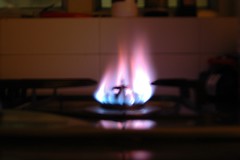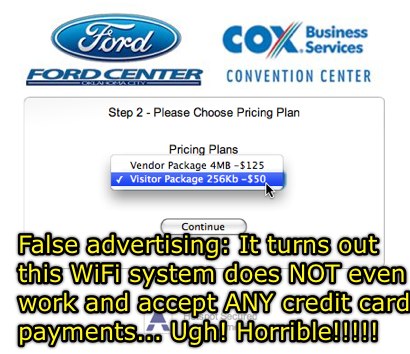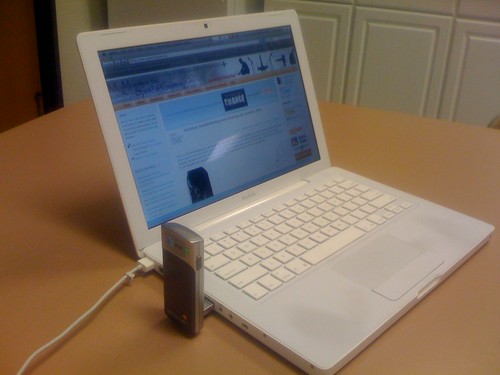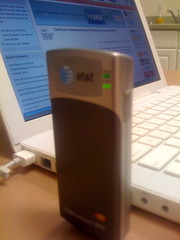The burn of a stove is a memorable instructor.
As I share presentations and workshops about educational technology tools as well as instructional strategies with teachers in different places, getting online and getting to the websites I need to access is frequently a challenge. Many school districts have networks which require a proxy configuration. Some are not setup to use DHCP, so I have to obtain static IP settings from the network administrator in advance to get online. If wireless is used, most organizations (rightly so) have WEP or WPA password security. Some (like UCO in Edmond now) require not only authentication of users, but (for Macintosh users only) also require registration of your WiFi card’s MAC address in their central database before you can gain wireless access. Headaches, headaches, headaches. Even when the network does provide a DHCP address and ready access to the web, all the K12 school districts in which I work use content filters which limit websites which can be accessed. Those blocked websites are not just limited to social networking sites like MySpace, YouTube, and “objectionable content” sites– frequently my presentation/workshop curriculum site on PBwiki is blocked, my blog is blocked, VoiceThread is blocked, Google Documents are blocked, etc, etc. Connectivity situations and requirements are always dynamic and always challenging.
Of course, getting online at all is a real plus. Sometimes, there is no connectivity or very limited connectivity at an educational conference where I’m presenting.
That was the case in October of 2006, shortly after I started my new job as an “education advocate,” and was presenting at the ESC 9 conference in Wichita Falls in the city’s convention center. I was sharing a presentation about Internet Searching, and apparently the folks in the session right next door were trying to web-stream very large videos during my entire session. The result? Even though I was online, the bandwidth available to my laptop over the provided WiFi connection was so poor I couldn’t show participants in my session anything “live” online.
That’s a presentation experience that leaves a BURNING sensation in your mind, to say the least…..
As a result of that experience, I started ALWAYS doing the following when I present in schools or at a conference:
- Requesting a WIRED Internet connection instead of relying on the available WiFi connection, which can be less reliable in terms of bandwidth.
- Bringing a multimedia presentation including screenshots of the topics and ideas I wanted to share with folks, to use as a backup in case (for some reason) Internet connectivity was slow or not available.
Fast forward to last week, at the annual Oklahoma Technology Association (OTA) annual conference here in Oklahoma City. I was scheduled to share four sessions. I developed keynote slides for the first three, but the last session was… again… on Internet searching. I had intended to develop a multimedia slideshow with screenshots of the main websites and techniques I wanted to discuss, but time ran short and I thought to myself, “This is a presentation all about Internet searching. This will be so much better to share as LIVE searches, rather than just a slideshow of static screen snaps. This is 2008. SURELY we’ll have reliable Internet access at the state educational technology center, hosted at the Cox Convention Center in downtown OKC. Surely Cox Communications will provide robust Internet connectivity in the conference rooms for presenters, since the facility is itself ostensibly a marketing tool for Cox Business Services as well as residential high speed Internet access.”
Boy was I ever WRONG, and boy did I ever get BURNED.
First, I want to note that this post is not a jab or dig at the OTA volunteers and staff. I think the OTA conference was wonderful, and I know lots of hard work made it possible. I appreciate all the work of many to make this educational technology conference a reality for Oklahoma educators. The point of these comments regarding the OTA conferences is…. We still have a long way to go in Oklahoma, not just in our schools when it comes to educational technology utilization, but also in our statewide education conferences.
My first problem at the conference was, it was BYOP for presenters. Not familiar with the acronym BYOP? In this context, I mean “Bring Your Own Projector.” That’s right, at an educational technology conference, LCD projectors were NOT PROVIDED for presenters. Even invited spotlight speakers! OTA did make this plain in its communications prior to the conference with presenters, so this shouldn’t have come as a “surprise” sprung on anyone at the conference. Still, for the statewide educational technology conference, I think this was very poor form.
The second major complaint I had at OTA this year regarded bandwidth. NO WIFI WAS PROVIDED AT THE CONFERENCE AT ALL. Not only was WiFi not provided at the conference, it was ADVERTISED as available from the Cox Center for a fee, but the system would not accept credit cards and didn’t work. This was and is not only an embarrassment to Cox Communications as a company, but is an embarrassment to our entire STATE.
The Cox Convention Center downtown is THE primary location for many of our largest statewide conferences each year, including many of the educational conferences hosted by the State Department of Education. To have NO WIFI available at all, even for people who are willing to PAY for it, and to have it advertised AS AVAILABLE, is ridiculous. I talked with the AV setup crew after my final presentation at OTA, and they told me that not only does the WiFi at the Cox Center not work, this is FREQUENTLY a problem with events that are hosted there. SHAME, SHAME, SHAME. BAD, BAD, BAD.
My final presentation at OTA last week on Internet Searching was a “spotlight session,” so it was held in three ballrooms that were opened to each other and connected. The room was HUGE. I was able to provide my own LCD projector, even though this was a spotlight presentation, but I assumed a wired Internet connection would be available in the room for use by the presenter. After all, in the other smaller breakout rooms, a wired Internet connection was available, and those connections actually WORKED.
Again, as in the case of the WiFi connectivity, in the ballrooms (9, 10, and 11) a wired ethernet cable was provided at the presenter podium, but IT DID NOT WORK. I contacted the Cox Center personnel in the business services office prior to the start of my session, explained the situation, and requested that someone come to help because my session required Internet access and started in ten minutes. NO ONE CAME TO HELP.
The result? A big bandwidth burn on Wesley. A big one. One that even left a blister. Try explaining del.icio.us and Google Notebook to an audience without any connectivity or screenshots. It wasn’t pretty.
That brings us to today.
Today, I am pleased to say I am among those who can successfully comply with the directive to “BYOB” to a presentation or educational technology workshop. In this context, by “BYOB” I’m referring to is “bring your own bandwidth.” I have to give credit to Karen Montgomery and others at METC for coining that clever phrase. Do I want to BYOB all the time? No, I would certainly rather have access to an even higher bandwidth connection if it is available. However, in the event a wired ethernet or WiFi connection is NOT available…. as it is not for me now waiting for my son to finish his “Intro to Musical Theater” class… that is no longer a problem.
Thanks to my AT&T Sierra Wireless USBConnect 811 laptop connector and the free Sierra Wireless “watcher” software for my MacBook, I’m able to BMOB – “Bring my own bandwidth!” 🙂
Technorati Tags:
att, wireless, laptop, bandwidth, ota, ota08, conference, education, connectivity, burn, cox, coxcommunications, oklahoma, oklahomacity, convention, conventioncenter
If you enjoyed this post and found it useful, subscribe to Wes’ free newsletter. Check out Wes’ video tutorial library, “Playing with Media.” Information about more ways to learn with Dr. Wesley Fryer are available on wesfryer.com/after.
On this day..
- Tags and Hashtag Literacy – 2022
- The Mobile Storyteller of North Canton City Schools, Ohio – 2018
- Security, Privacy, and Digital Citizenship (February 2017) – 2018
- Learning at #TXeducamp in Denton, Texas – 2016
- Find & Highlight Duplicates in Excel 2011 for Mac – 2015
- Student Oral Reports with School Hallway Dioramas via AudioBoo – 2013
- Manipulated FoxNews Video Shows Why eBooks are the WRONG Choice for K-12 1:1 Environments – 2011
- Civil War Augmented Reality Project Becomes HistoriQuest – 2011
- Photo memories in an old box – 2010
- WordPress for iPhone 2.2 Even Better – 2010






Comments
12 responses to “BYOB – Bring Your Own Bandwidth”
I use that same connection card (but with Sprint). It works great. I’ve had mine for a few months and I wish I would have gotten it a long time ago. Having my own bandwidth has saved me so many headaches because you’re right–a presenter just cannot rely on a conference’s or institution’s Internet connection.
(It’s also cool when the power is out–your can still be online with your laptop.)
Cool, glad to know you’ve had good results with the same card. I didn’t think about the power outage feature– that would have come in handy during our ice storms in Oklahoma earlier this winter! Hopefully we won’t have another opportunity to test connectivity under those conditions this year! 🙂
I so want one of those. Just started touring about the place this week and came up against a brick wall of how to access the non ‘ubiquitous’ internet.
Heaps of my stuff is on line- I can open a whole lot in tabs and show that way but you don’t get the inter-connectedness if you can’t be live- trying to explain twitter and not be able to show someone it just sounded silly.
Once you actually buy the unit you are then faced with bandwidth charges- that would bring the cost up a lot- at least it would here in NZ where our broadband is real S-L-O-W. I already pay $50 a month for a 6GB cap.
Sorry I am totally amazed. This was a technology conference? Even in Australia our venues provide data projectors – that should be a given. Definitely a plus having your own bandwidth although it is very costly here.
It has taken a few years, but the Sturbridge Host Hotel where the MassCUE conference is held offers projectors in every breakout room and free WIFI for everyone. I was at a Will Richardson workshop that was so popular the IT staff had to setup an extra WIFI router in the room. I was impressed that the hotel staff worked throughout the day to make sure everyone had Internet access.
Wes, also thanks for the link to the Obama campaign. I have been thinking of sending him some money and the link made it easy. The Yes We Can video is very powerful and I will be sending links to my friends.
Wes, network and other technical woes certainly test the “stuff” presenters are made of! You need to get one of those “Been there. Done that. Got the scars to show for it.” T-shirts. Cell-based Internet cards are a great idea, especially those that work on 3G and other higher bandwidth networks. I will keep that in mind, yet pray that I don’t need one. I have had good luck so far.
Most of the time I’m trying to share cool stuff on the computer to a classroom of students and haven’t found the bandwidth to be a problem but the firewall with its strangely configured blacklist. Being part of a lumbersome bureaucracy, getting site approvals puts a lot of front end organizing into the work. Moving to a card would work for me but then how do the students ever get a chance?
Wes, just recently I went with a similar product from Verizon to address our lack of broadband in my community (that and my landline got dug up!). I’m really loving the physical disconnection and nomadic encouragement that this device provides! It strikes me that when we are working with educators at their facility, behind their firewall, that perhaps admin/IT folks should be present to see the power that many of these blocked services carry. Sometimes the message and cost comparison is more powerful when it is illustrated (in a nice way of course).
But that brings up Ed’s point: “…how do the students ever get a chance?” Are we sending them the message that learning is limited within school walls? Is that the kind of message that schools wish to send?
I’ve joked with my wife to be subversive and use our cellular wireless card with her personal laptop in her class so that her students can see what they’re missing. But the reality is that it would probably cost her her job despite the fact that what she is doing is in the best interest of her students.
And the battle rages on… for now the casualties are limited to the global growth of our students but at some point its effects will be felt by the rest of us, when our students are unable to compete in a global economy.
[…] when preparing a presentation where the web is fairly crucial. The inimitable Darren Kuropatwa and Wes Fryer had a little meltdowns as […]
Thursday was a bad day to do presentations it seems. 😉
Wish I had one of those doohickies with me then. 😉
[…] a back-up plan or two! At least I haven’t had any of Wes Fryer’s problems like this and this. I do have comfort though in that he offers solutions to consider. Will I give up? Nah. Just plan […]
Check out http://www.proxylord.com to access blocked web sites. It is very fast and secure. Works on Youtube also!